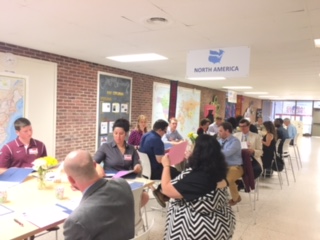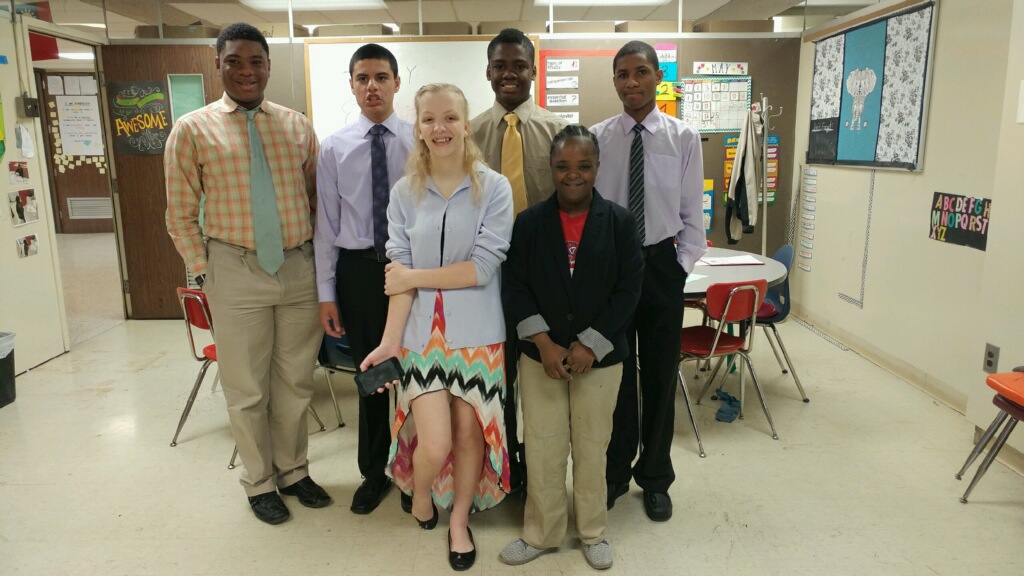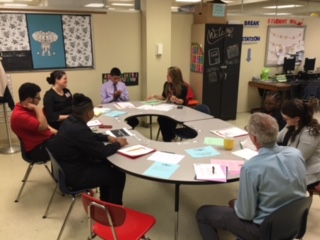At Lincoln-West School of Global Studies, students are gaining the skills to be master presenters through twice yearly Exhibitions of Learning (EOLs). We asked founding principal, Dr. Irene Javier, to tell us about how her and her design team developed this key instructional approach that supports students to explore their interests, brings community members into the school, and prepares students for college and career through service learning expeditions. We asked Dr. Javier about the EOL design process and what advice she would give to schools who are designing or iterating a similar approach.

How did you design the Exhibitions of Learning experience? How did you set students up to participate in the first round this past winter?
In designing the Exhibition of Learning experience, my design team and I defined what the experience would look like and what we hoped to accomplish. We started this work last September with the goal of supporting students to demonstrate their learning and exhibit it in a variety of ways. We saw this as a great opportunity for students to express choice and voice in their learning.
Each semester, students complete a set of performance tasks in each content area called anchor performance tasks. They select one of these tasks to focus on for their EOL. Many tasks include a service learning expedition—where students go out into the real world and identify community-based problems that they want to solve. Service learning is important at LWGS, and we are working to weave it more deeply into the framework of core classes and our EOL work.
As we planned the scope of our EOL programming using the school’s competency-based model, we drafted the rubric, clarified expectations about EOL-worthy anchor performance tasks, and created an exemplar EOL by hosting mock roundtables. My design team and I played the role of students and community partners to figure out exactly how this would work. We quickly made some key decisions, including who comprises an 8-person EOL assessment team, which is no more than 6 students (known as “critical peers”), community partners, and a staff facilitator.

How did you support students to be ready for EOL presentations as a first-year school?
One of the most exciting parts of this design process was figuring out how to support students to identify EOL topics and making sure expectations were clear. We knew early on that we wanted them to reflect problems in the local community that have global significance. This, in turn, led to an instructional dialogue where we saw a need to build teacher capacity and knowledge through professional development.
Our advisory structure was a key to work with students to prepare for their EOLs. Every student received materials that outlined the anchor performance tasks they could choose for their EOL. Once they selected the anchor performance task, they got sign off from the content teacher and their advisor. This formed the basis of support for their EOL journey and staff were able to personalize student supports throughout the semester.
How did you engage community partners in this work?
We worked to recruit community partners to join the assessment teams by making a map of everyone we have relationships with (or wanted to cultivate relationships with) and calling around to see who’d be interested in participating. We’ve been fostering relationships with key community partners since our design year and saw this as a great opportunity to invite them to have an even deeper contribution to the school. Our community partners found this to be a meaningful touchpoint—everyone who participated in our first EOL round not only came back for the second round but they invited and brought their peers and colleagues.
When we created documents for our various stakeholders, we were careful to make sure that our communications to community partners came across clearly and gave them enough context about our competency-based approach. We also invited community partners to arrive early on EOL day so we could talk them through what to expect and answer any questions.

What did you iterate on from the first round of EOLs to the second one that took place this June?
Students had a great experience with our first round of EOLs, and before it even ended, my design team and I were looking toward the next round. Students and teachers spent a lot of time reflecting and action planning for June. The design team took these learnings, as well as our own reflections, to formulate the basis of our iteration approach. We discovered that we wanted to refine elements like grading protocols in order to calibrate our rubrics. This is especially important our community partners may not be familiar with competency-based learning. We looked at student work samples and determined standard ratings alongside the rubric. This data was shared with EOL assessment teams in preparation for the June round of EOLs.
This process also allowed us to ask important questions and formulate a shared understanding of what students should be working toward. My staff and I can support students and guide them in their EOL journey from an earlier point in the semester. Students, too, now have a sense of what they are working toward in their EOLs and we’re all excited to see how this work will continue to evolve.
What is your advice for other school leaders who might be interested in launching something like this?
Schools that set out to design EOL experiences for students should have a growth mindset as a foundation for doing this work—for both adults and students. Reflection is a major part of the process and I would encourage any school to make it a core component. For instance, assessment teams provided “grows and glows” to students immediately after they presented, following a short period in which student presenters stepped out of the room to allow the assessment team to discuss the feedback. Students received their scored rubrics later in advisory and had a chance for a lengthier debrief with their advisors. Four key questions helped guide student thinking and keep them engaged as they reflected and thought through learnings.
You also need a strong approach to advisory—or another dedicated time to prepare students for EOLs. Though all classes are preparing students for EOLs, it is important to have a set time where staff facilitates activities that guide and support students in this endeavor.
Lastly, it’s really important for kids to have clear expectations and understand the path to a successful EOL. For example, at LWGS, the anchor performance tasks are the way in—they shape the EOL and all planning stems from that work. It’s also helpful to ensure that all school staff are on the same page and can articulate the instructional model and vision.
We were aware that EOLs are not common for a first-year school but my team and I decided to be ambitious and our confidence and preparation paid off—we had 98% participation and completion on both rounds. We can’t wait to see how round three goes this winter!